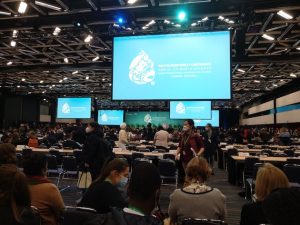
A dog trained under Africa Wildlife Foundation’s Canines for Conservation programme looks content with its handlers. Sniffer and tracker dogs deployed in six African countries have contributed to the arrests of over 500 suspects in the long-running fight against poachers and traffickers. Credit: Paul Joynson-Hicks
By Guy Dinmore
London, Dec 9 2022 – Elephant populations are starting to recover in parts of Africa as law enforcement agencies and local communities turn the tide in their long-running battle against wildlife poachers and traffickers.
But criminal gangs are constantly shifting tactics and exploiting other species, while the greatest threat now is posed by the severe drought devastating swathes of East Africa, displacing hundreds of thousands of people, threatening famine in Somalia, and killing off wildlife and livestock.
“Poaching of big game is going down in most countries,” says Didi Wamukoya, senior manager of Wildlife Law Enforcement at African Wildlife Foundation (AWF), noting that poaching in Kenya and Tanzania of large iconic species for the international wildlife trade is now very rare. Elephant population numbers in those two countries are now increasing. It is a particularly dramatic turnaround for Tanzania, which lost some 60 percent of its elephants within a decade.

Elephant population statistics. Credit: AWF
Wamukoya, who heads AWF’s capacity training of law enforcement agencies to prosecute cases of wildlife trafficking, warns that criminals adapt. While elephants are faring better – also in part because major markets such as China have banned domestic trade in ivory — gangs trafficking to Asia are switching to other species, such as lions for their body parts, pangolins, and abalone.
Pangolins, which have been identified as a potential source of coronaviruses, are the most trafficked wild mammals in the world.
Combating cybercrime and enhancing the use of digital evidence in courts have become a key elements of AWF’s work as criminals adapted to Covid-19 lockdowns. “Criminals live in society and are part of us, and they moved online too,” Wamukoya told IPS in an interview, referring to social media platforms like Facebook used to market animals and wildlife products.
Much illegal wildlife trade – estimated by international agencies to be worth over $20 billion a year globally – has moved online, but the actual poaching and transporting of smuggled animals and products across borders is the target of AWF’s Canines for Conservation Programme, headed by Will Powell in Arusha, Tanzania.
Powell and his team train sniffer and tracker dogs as well as their handlers selected from ranger forces across Africa, including most recently Ethiopia.
“We are having to raise standards of our operations with dogs at airports as smugglers try to adapt and hide stuff in coffee, condoms, screened by tinfoil. First, rhino horn and ivory were the main target but now pangolin scales are the biggest thing, so dogs are trained on this,” he tells IPS.
Trafficking in lion bones and teeth for Asian ‘medicine’ has also gone up as criminals switch from tigers. “We have to be sure dogs are up to date,” he says.
Powell previously trained dogs to sniff out 32 kinds of explosives in the Balkans and says over 90 percent of dogs can refind a smell after a year without exposure to it. A new smell can be introduced with just hours of training.
“Ivory is a range of smells from freshly killed to antique pieces. Dogs are amazing at how they figure it out, for example, by not responding to cow horn but picking out tortoises,” he says.

A sniffer dog trained by AWF works in a Kenya airport. They are trained in wide ranges of smells and can learn to detect a new one within hours as traffickers constantly change their smuggling methods. Credit: Paul Joynson-Hicks
AWF canine teams currently work in Botswana, Cameroon, Kenya,
Mozambique, Tanzania, and Uganda. All staff are local nationals. Since 2020 teams operating in Manyara Ranch and Serengeti National Park in Tanzania have made over 100 finds, resulting in multiple arrests.
No elephants in the Serengeti have been lost to the international wildlife trade since the canine teams have been in place.
AWF says that dog units across the six countries have uncovered over 440 caches that led to the arrest of over 500 suspects. Finds have included over 4.6 tonnes of ivory, 22kg of rhino horns, over 220 lion claws, 111 hippo teeth. Seven live pangolins were recovered, and over 4.5 tonnes of pangolin scales.
Dogs and their handlers are also impacting corruption among officials and law enforcement agencies.
“Dogs are an incorruptible tool,” explains Wamukoya. Dealing with corruption is part of training for rangers and handlers. The transparency of their work and with handlers trained to send photos of seizures high up to authorities, corruption is made more difficult.
“Corruption is not zero but we are seeing light at the end of the tunnel,” she says.
Tanzania has been known as the world’s elephant killing fields, but a crackdown on poachers and traffickers in recent years has halted a horrendous decline in elephant numbers. On December 2, a Tanzanian high court sentenced to death 11 people for the murder of Wayne Lotter, a well-known South African conservationist who was shot in a taxi in Dar es Salaam in August 2017. The sentences are likely to be commuted to long jail terms.
Compiling accurate estimates of Africa-wide populations of various species, including big beasts such as elephants, is widely recognised as extremely difficult. So is the gathering of statistics on poaching and seizures of trafficked animals. The 2020 World Wildlife Crime Report by the UNODC attempts to unpick and track the trends since its 2016 edition, noting that lockdown measures taken by governments during the Covid pandemic forced organised criminal groups to “adapt and quickly change their dynamics”, possibly resulting in “illicit markets going even deeper underground, additional risks for corruption and shifts in market and transportation methodologies in the longer term”.
It estimates some 157,000 elephants were poached between 2010 and 2018, an average of about 17,000 elephants per year. Data suggests a declining trend in poaching since 2011 but rising again slightly in 2017 and 2018. While elephant numbers are growing in Tanzania, Uganda and Kenya, there is a worrying decline in ‘critically endangered’ forest elephants in Central and West Africa because of loss of habitat and poaching.
The UNODC said a “trafficking trend of note” was more mixed seizures containing both ivory and pangolin scales together, singling out a container coming from the Democratic Republic of Congo on its way to Vietnam in July 2019, found to hold nearly 12 tonnes of pangolin scales and almost nine tonnes of ivory. The consignment was declared as timber.
“It is possible that ivory traffickers, facing declining demand, are taking advantage of their established networks to move a commodity for which demand is growing: pangolin scales,” the report said.
Save the Rhino International, a conservation charity, says poaching numbers have decreased across Africa since the peak of 1,349 in 2015, but still at least one rhino is killed every day. South Africa holds the majority of the world’s rhinos and has been hardest hit by poachers.

A consignment of illegally trafficked pangolin scales and elephant ivory seized in Kenya. Pangolins are the most trafficked wildlife mammal in the world. Dogs trained by AWF have sniffed out a total of 4.5 tonnes of pangolin scales in six countries. Poaching of elephants and rhinos in Kenya is now rare as the government, local communities, and NGOs step up efforts to stop wildlife trade. Credit AWF
These are hard-fought gains against wildlife traffickers that still need to be reinforced through support and training of law enforcement agencies, greater participation of local communities in conserving wild areas and wildlife, and reforms of legal systems. Support from governments outside Africa, particularly in Asia, is vital to tackle shifting markets and trading routes.
But now, the most devastating and immediate threat in East Africa is the worst drought in 40 years. Four consecutive seasons of drought over the past two years have taken a dramatic toll on people, livestock, and wildlife.
In early November, the Kenya Wildlife Service reported the deaths of 205 elephants, over 500 wildebeest, 381 common zebras, 49 endangered Grevy’s zebras, and 12 giraffes within nine months. Rangers are removing tusks from dead elephants to stop poachers taking them.
“It is a tragedy despite all our efforts,” says Wamukoya. “Wildlife is not dying for poaching but it is drought and affecting the human population. Pastoral cattle communities no longer have pasture or food. Livestock are dying.”
IFAW, a global non-profit that helps people and animals thrive together, quoted Evan Mkala, program manager for Kenya’s Amboseli region, as saying he has never seen anything so devastating. “You can smell the rotting carcasses all around the area.” He says poaching is back on the rise as people lacking food security are desperate for money to buy water and hay for their cattle.
The Horn of Africa is described by the UN World Food Programme as “a region at the intersection of some of the worst impacts of climate change, recurring humanitarian crises and insecurity”.
It says over 22 million people face a severe hunger crisis in a swathe of territory covering parts of Somalia, Ethiopia, Djibouti, northern Kenya, and South Sudan. Over one million people have been displaced by drought; seven million livestock have died. A poor start to the October-December rains has initiated a fifth consecutive season of drought.
“This is the worst drought, the driest it’s ever been in 40 years. So, we are entering a whole new phase in climate change,” said Michael Dunford, WFP regional director for East Africa. “Unfortunately, we have not yet seen the worst of this crisis. If you think 2022 is bad, beware of what is coming in 2023. This means that we need to continue to engage. We cannot give up on the needs of the population in the Horn.”
IPS UN Bureau Report


